Abstract
The ability to express heterologous antigens from attenuated poliovirus strains suggests the potential for use as live vectored vaccines. Full- or partial-length sequences of the gene encoding rotavirus major outer capsid protein VP7 were cloned into the open reading frame of a full-length cDNA copy of poliovirus Sabin type 3. They were inserted either at the 5' end or immediately after the capsid protein coding region, at the junction between precursors P1 and P2. A protease cleavage site for 3C protease was introduced 3' to the foreign sequences to enable proteolytic processing of the antigen from the poliovirus polyprotein. Infectious viruses were generated from several of the DNA constructs, and the presence of the foreign gene sequences was confirmed by reverse transcription of the viral RNA and PCR amplification. Viruses with inserts of about 300 bases maintained the foreign sequences during passage in Vero cells. Viruses carrying larger sequences were unstable, and deletions were generated within the foreign sequences. Expression of the VP7 polypeptides was demonstrated by immunoprecipitation with specific antiserum of labeled proteins from cells infected with Sabin 3 recombinant viruses. Comparative studies of RNA synthesis showed similar kinetics for Sabin 3 and the Sabin 3/VP7 recombinants. One-step growth curves showed that production of recombinant viruses was slower than that of Sabin 3 and that the final titers were 1 to 1.5 logs lower. Accumulation of VP7-containing precursors in infected cells suggests that slow cleavage at the engineered 3C protease site may be a limiting step in the growth of these recombinant Sabin polioviruses and may influence the permissible size of foreign sequence to be inserted.
Full text
PDF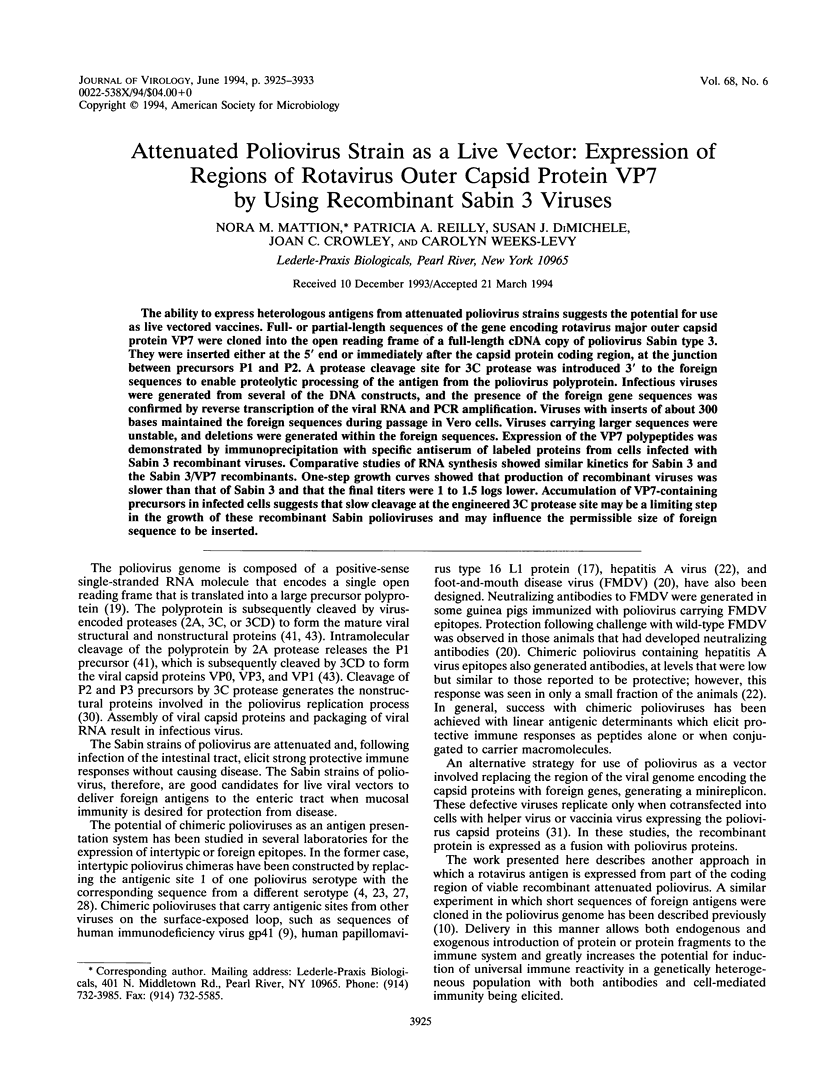
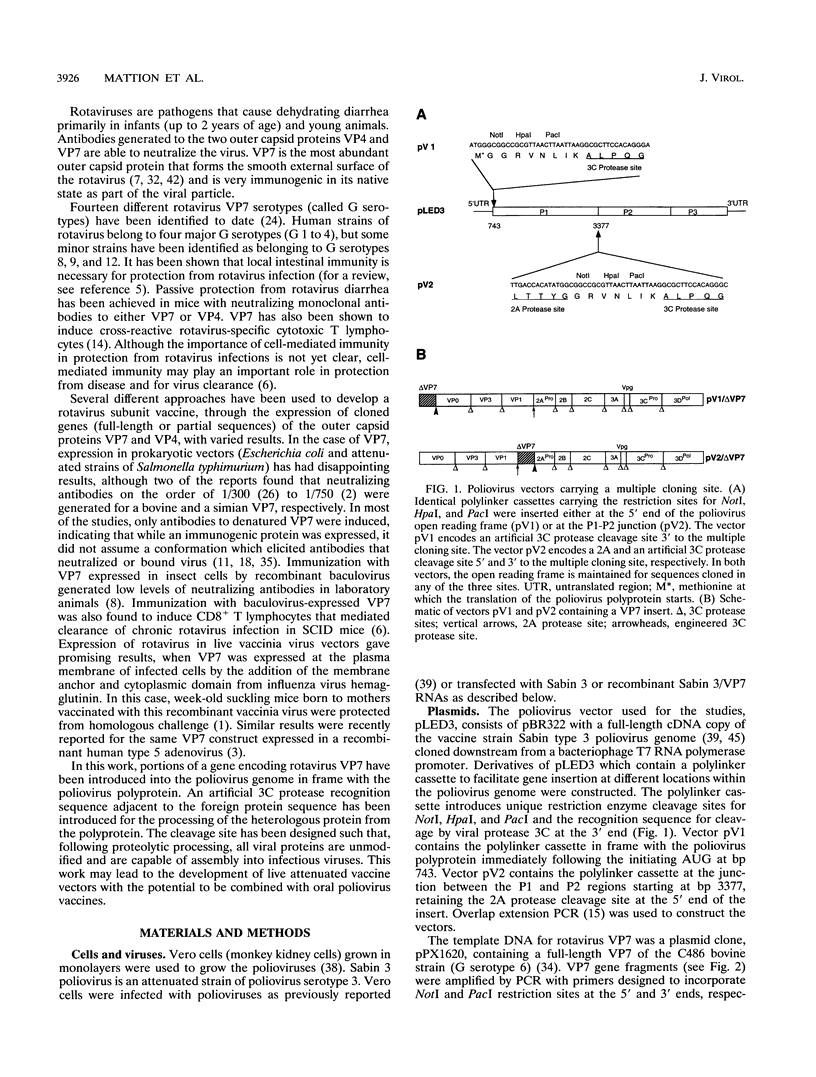
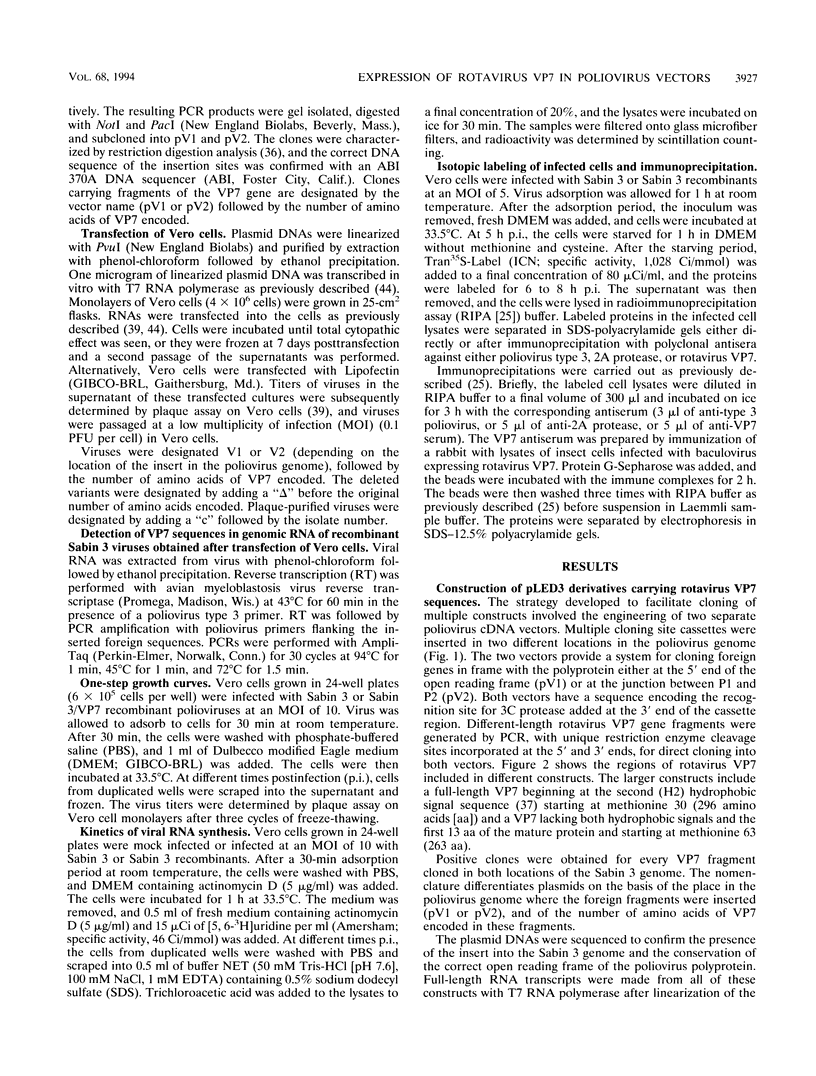
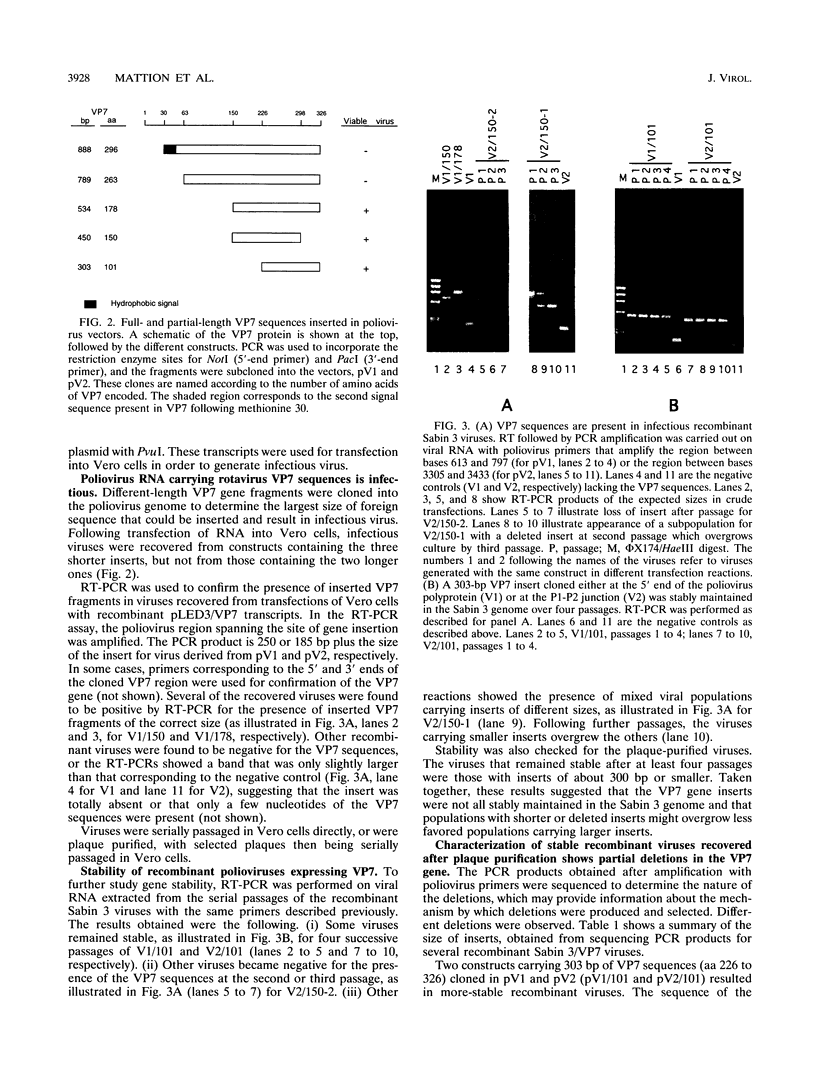
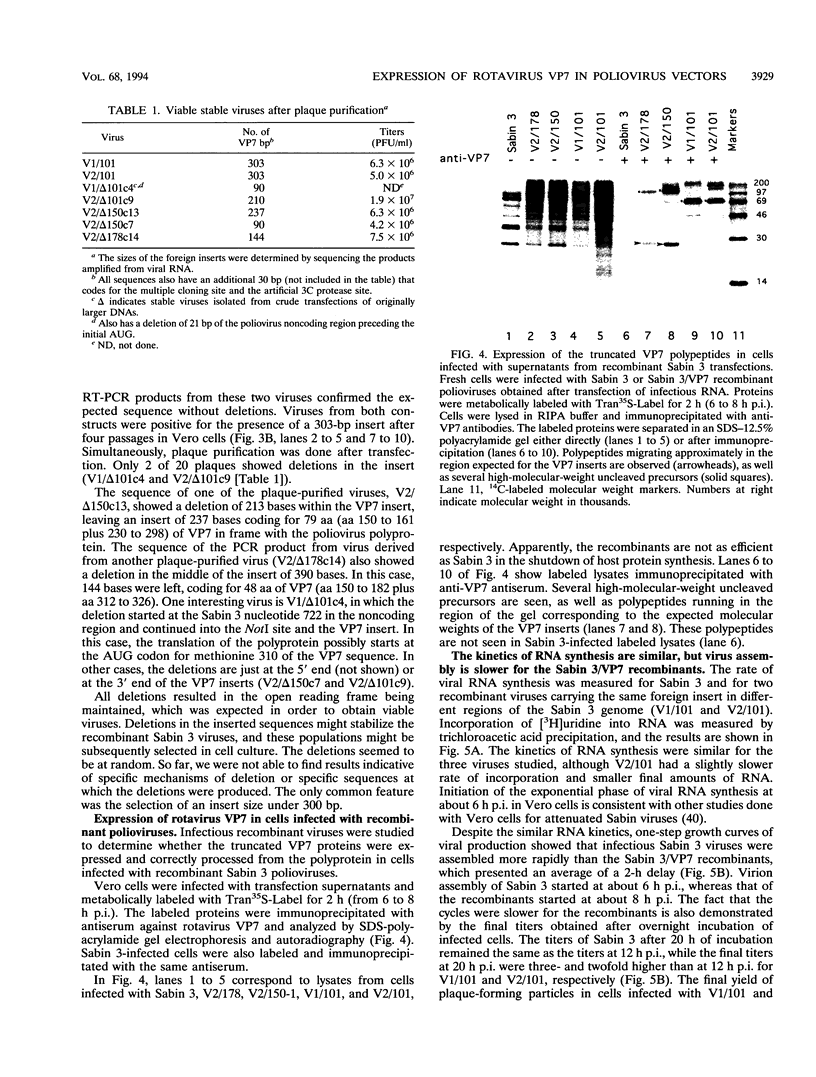
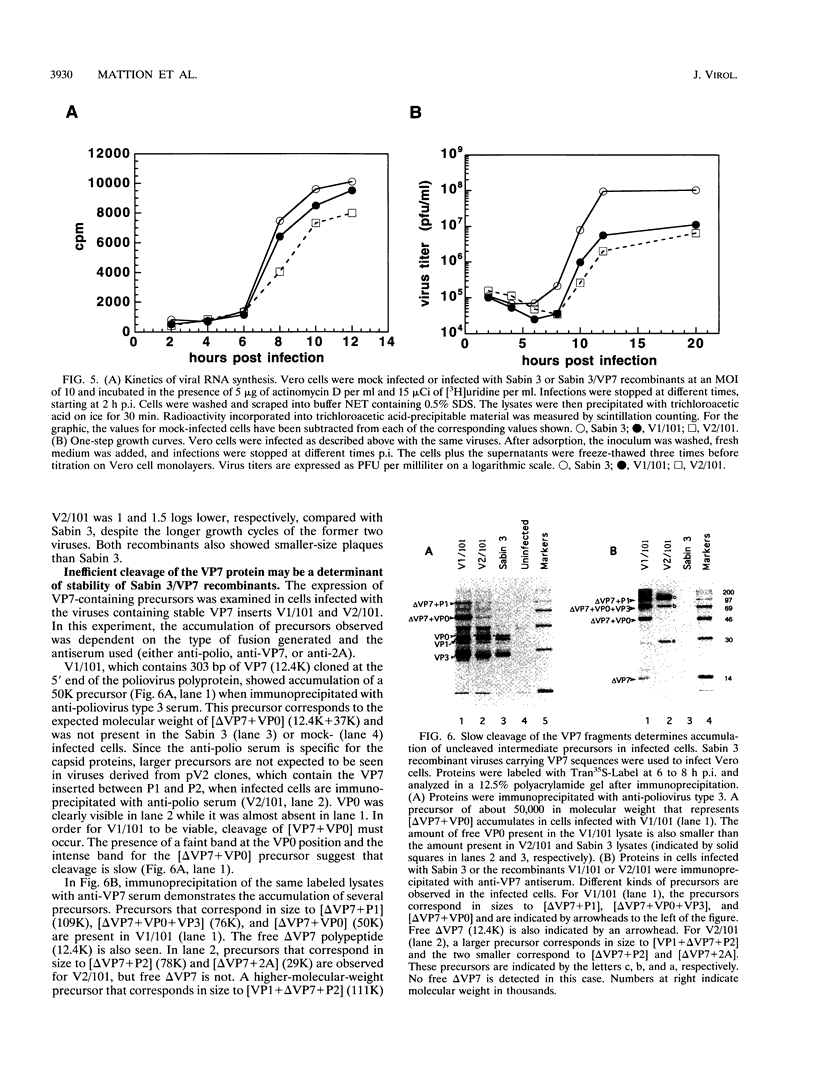
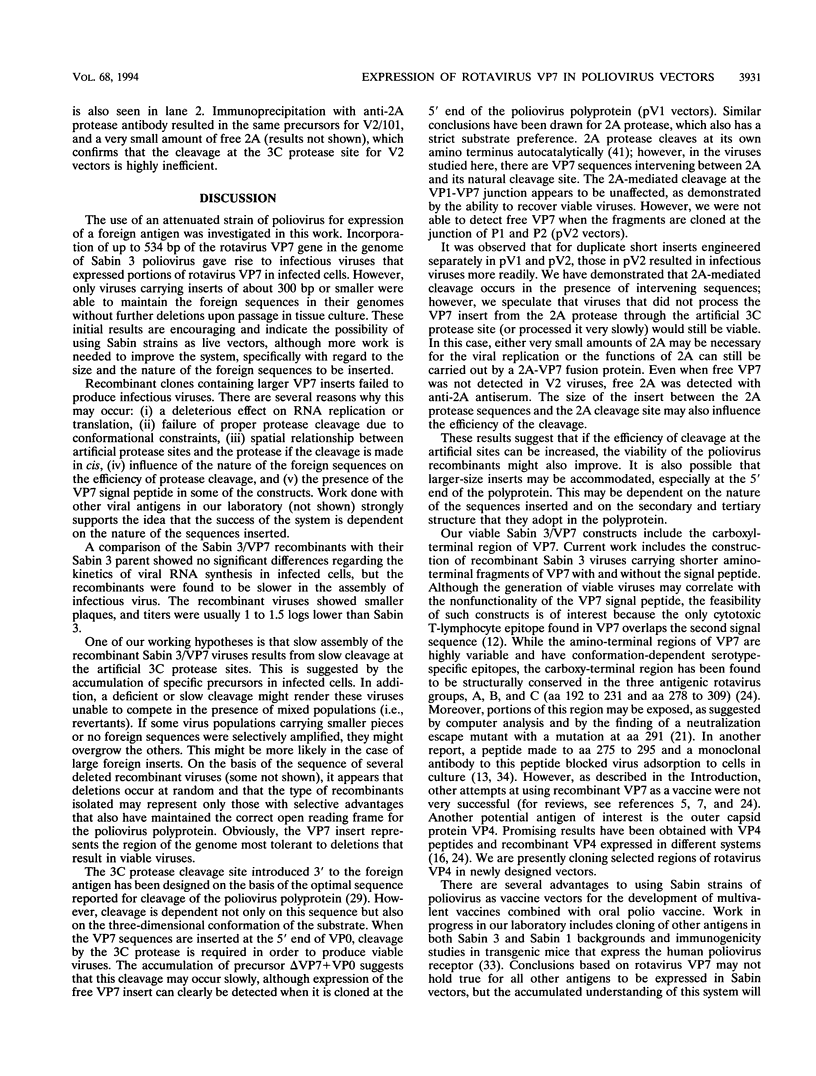
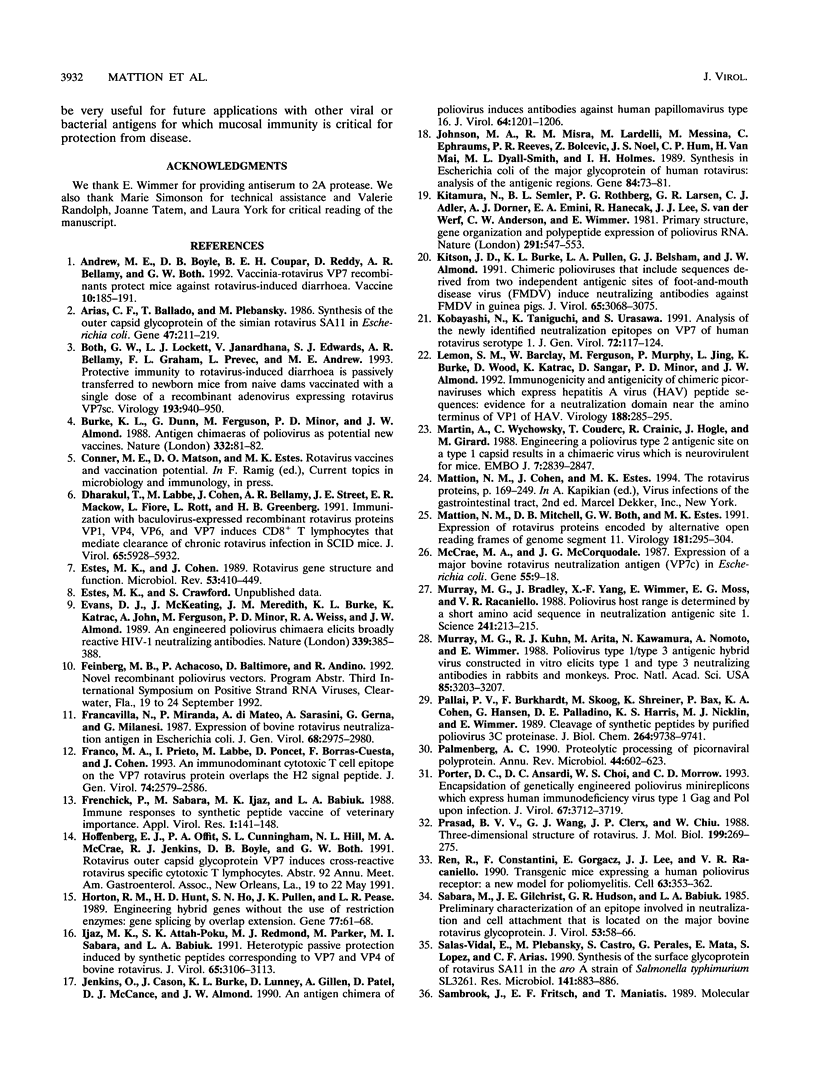
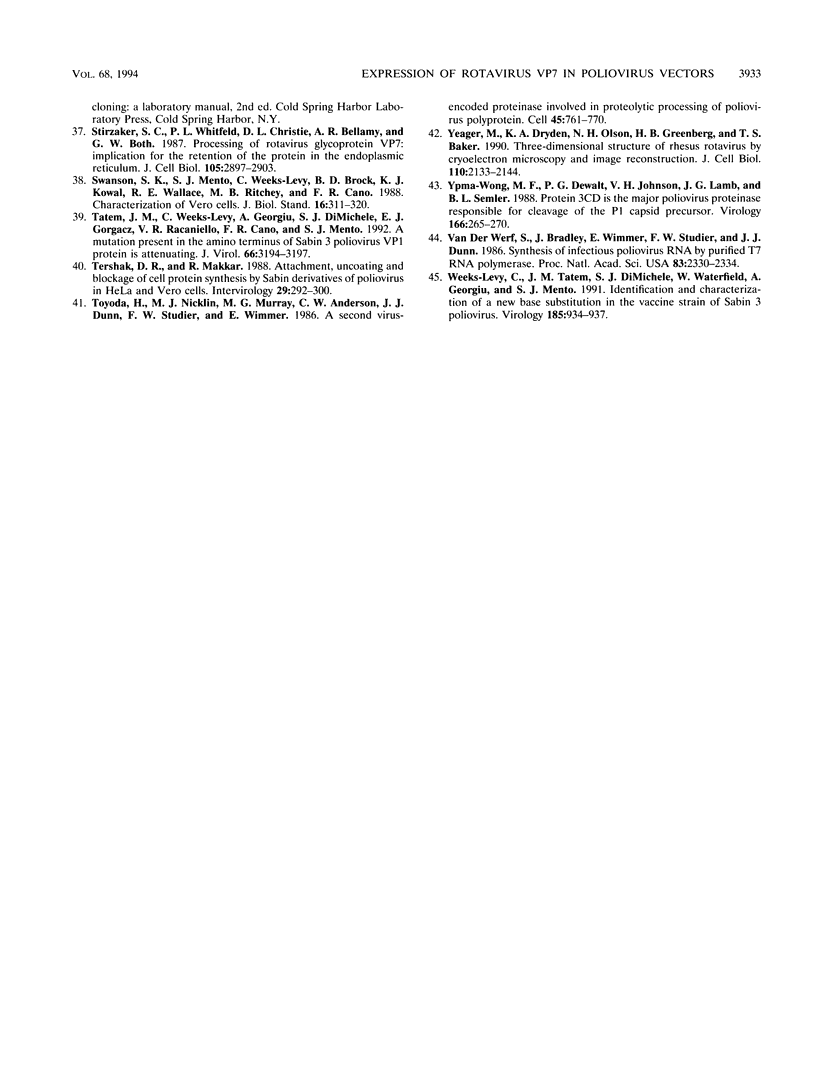
Images in this article
Selected References
These references are in PubMed. This may not be the complete list of references from this article.
- Andrew M. E., Boyle D. B., Coupar B. E., Reddy D., Bellamy A. R., Both G. W. Vaccinia-rotavirus VP7 recombinants protect mice against rotavirus-induced diarrhoea. Vaccine. 1992;10(3):185–191. doi: 10.1016/0264-410x(92)90010-h. [DOI] [PubMed] [Google Scholar]
- Arias C. F., Ballado T., Plebañski M. Synthesis of the outer-capsid glycoprotein of the simian rotavirus SA11 in Escherichia coli. Gene. 1986;47(2-3):211–219. doi: 10.1016/0378-1119(86)90065-x. [DOI] [PubMed] [Google Scholar]
- Both G. W., Lockett L. J., Janardhana V., Edwards S. J., Bellamy A. R., Graham F. L., Prevec L., Andrew M. E. Protective immunity to rotavirus-induced diarrhoea is passively transferred to newborn mice from naive dams vaccinated with a single dose of a recombinant adenovirus expressing rotavirus VP7sc. Virology. 1993 Apr;193(2):940–950. doi: 10.1006/viro.1993.1203. [DOI] [PubMed] [Google Scholar]
- Burke K. L., Dunn G., Ferguson M., Minor P. D., Almond J. W. Antigen chimaeras of poliovirus as potential new vaccines. Nature. 1988 Mar 3;332(6159):81–82. doi: 10.1038/332081a0. [DOI] [PubMed] [Google Scholar]
- Dharakul T., Labbe M., Cohen J., Bellamy A. R., Street J. E., Mackow E. R., Fiore L., Rott L., Greenberg H. B. Immunization with baculovirus-expressed recombinant rotavirus proteins VP1, VP4, VP6, and VP7 induces CD8+ T lymphocytes that mediate clearance of chronic rotavirus infection in SCID mice. J Virol. 1991 Nov;65(11):5928–5932. doi: 10.1128/jvi.65.11.5928-5932.1991. [DOI] [PMC free article] [PubMed] [Google Scholar]
- Estes M. K., Cohen J. Rotavirus gene structure and function. Microbiol Rev. 1989 Dec;53(4):410–449. doi: 10.1128/mr.53.4.410-449.1989. [DOI] [PMC free article] [PubMed] [Google Scholar]
- Evans D. J., McKeating J., Meredith J. M., Burke K. L., Katrak K., John A., Ferguson M., Minor P. D., Weiss R. A., Almond J. W. An engineered poliovirus chimaera elicits broadly reactive HIV-1 neutralizing antibodies. Nature. 1989 Jun 1;339(6223):385-8, 340. doi: 10.1038/339385a0. [DOI] [PubMed] [Google Scholar]
- Francavilla M., Miranda P., Di Matteo A., Sarasini A., Gerna G., Milanesi G. Expression of bovine rotavirus neutralization antigen in Escherichia coli. J Gen Virol. 1987 Nov;68(Pt 11):2975–2980. doi: 10.1099/0022-1317-68-11-2975. [DOI] [PubMed] [Google Scholar]
- Franco M. A., Prieto I., Labbé M., Poncet D., Borras-Cuesta F., Cohen J. An immunodominant cytotoxic T cell epitope on the VP7 rotavirus protein overlaps the H2 signal peptide. J Gen Virol. 1993 Dec;74(Pt 12):2579–2586. doi: 10.1099/0022-1317-74-12-2579. [DOI] [PubMed] [Google Scholar]
- Horton R. M., Hunt H. D., Ho S. N., Pullen J. K., Pease L. R. Engineering hybrid genes without the use of restriction enzymes: gene splicing by overlap extension. Gene. 1989 Apr 15;77(1):61–68. doi: 10.1016/0378-1119(89)90359-4. [DOI] [PubMed] [Google Scholar]
- Ijaz M. K., Attah-Poku S. K., Redmond M. J., Parker M. D., Sabara M. I., Frenchick P., Babiuk L. A. Heterotypic passive protection induced by synthetic peptides corresponding to VP7 and VP4 of bovine rotavirus. J Virol. 1991 Jun;65(6):3106–3113. doi: 10.1128/jvi.65.6.3106-3113.1991. [DOI] [PMC free article] [PubMed] [Google Scholar]
- Jenkins O., Cason J., Burke K. L., Lunney D., Gillen A., Patel D., McCance D. J., Almond J. W. An antigen chimera of poliovirus induces antibodies against human papillomavirus type 16. J Virol. 1990 Mar;64(3):1201–1206. doi: 10.1128/jvi.64.3.1201-1206.1990. [DOI] [PMC free article] [PubMed] [Google Scholar]
- Johnson M. A., Misra R. M., Lardelli M., Messina M., Ephraums C., Reeves P. R., Bolcevic Z., Noel J. S., Hum C. P., Van Mai H. Synthesis in Escherichia coli of the major glycoprotein of human rotavirus: analysis of the antigenic regions. Gene. 1989 Dec 7;84(1):73–81. doi: 10.1016/0378-1119(89)90141-8. [DOI] [PubMed] [Google Scholar]
- Kitamura N., Semler B. L., Rothberg P. G., Larsen G. R., Adler C. J., Dorner A. J., Emini E. A., Hanecak R., Lee J. J., van der Werf S. Primary structure, gene organization and polypeptide expression of poliovirus RNA. Nature. 1981 Jun 18;291(5816):547–553. doi: 10.1038/291547a0. [DOI] [PubMed] [Google Scholar]
- Kitson J. D., Burke K. L., Pullen L. A., Belsham G. J., Almond J. W. Chimeric polioviruses that include sequences derived from two independent antigenic sites of foot-and-mouth disease virus (FMDV) induce neutralizing antibodies against FMDV in guinea pigs. J Virol. 1991 Jun;65(6):3068–3075. doi: 10.1128/jvi.65.6.3068-3075.1991. [DOI] [PMC free article] [PubMed] [Google Scholar]
- Kobayashi N., Taniguchi K., Urasawa S. Analysis of the newly identified neutralization epitopes on VP7 of human rotavirus serotype 1. J Gen Virol. 1991 Jan;72(Pt 1):117–124. doi: 10.1099/0022-1317-72-1-117. [DOI] [PubMed] [Google Scholar]
- Lemon S. M., Barclay W., Ferguson M., Murphy P., Jing L., Burke K., Wood D., Katrak K., Sangar D., Minor P. D. Immunogenicity and antigenicity of chimeric picornaviruses which express hepatitis A virus (HAV) peptide sequences: evidence for a neutralization domain near the amino terminus of VP1 of HAV. Virology. 1992 May;188(1):285–295. doi: 10.1016/0042-6822(92)90758-h. [DOI] [PubMed] [Google Scholar]
- Martin A., Wychowski C., Couderc T., Crainic R., Hogle J., Girard M. Engineering a poliovirus type 2 antigenic site on a type 1 capsid results in a chimaeric virus which is neurovirulent for mice. EMBO J. 1988 Sep;7(9):2839–2847. doi: 10.1002/j.1460-2075.1988.tb03140.x. [DOI] [PMC free article] [PubMed] [Google Scholar]
- Mattion N. M., Mitchell D. B., Both G. W., Estes M. K. Expression of rotavirus proteins encoded by alternative open reading frames of genome segment 11. Virology. 1991 Mar;181(1):295–304. doi: 10.1016/0042-6822(91)90495-w. [DOI] [PubMed] [Google Scholar]
- McCrae M. A., McCorquodale J. G. Expression of a major bovine rotavirus neutralisation antigen (VP7c) in Escherichia coli. Gene. 1987;55(1):9–18. doi: 10.1016/0378-1119(87)90243-5. [DOI] [PubMed] [Google Scholar]
- Murray M. G., Bradley J., Yang X. F., Wimmer E., Moss E. G., Racaniello V. R. Poliovirus host range is determined by a short amino acid sequence in neutralization antigenic site I. Science. 1988 Jul 8;241(4862):213–215. doi: 10.1126/science.2838906. [DOI] [PMC free article] [PubMed] [Google Scholar]
- Murray M. G., Kuhn R. J., Arita M., Kawamura N., Nomoto A., Wimmer E. Poliovirus type 1/type 3 antigenic hybrid virus constructed in vitro elicits type 1 and type 3 neutralizing antibodies in rabbits and monkeys. Proc Natl Acad Sci U S A. 1988 May;85(9):3203–3207. doi: 10.1073/pnas.85.9.3203. [DOI] [PMC free article] [PubMed] [Google Scholar]
- Pallai P. V., Burkhardt F., Skoog M., Schreiner K., Bax P., Cohen K. A., Hansen G., Palladino D. E., Harris K. S., Nicklin M. J. Cleavage of synthetic peptides by purified poliovirus 3C proteinase. J Biol Chem. 1989 Jun 15;264(17):9738–9741. [PubMed] [Google Scholar]
- Palmenberg A. C. Proteolytic processing of picornaviral polyprotein. Annu Rev Microbiol. 1990;44:603–623. doi: 10.1146/annurev.mi.44.100190.003131. [DOI] [PubMed] [Google Scholar]
- Porter D. C., Ansardi D. C., Choi W. S., Morrow C. D. Encapsidation of genetically engineered poliovirus minireplicons which express human immunodeficiency virus type 1 Gag and Pol proteins upon infection. J Virol. 1993 Jul;67(7):3712–3719. doi: 10.1128/jvi.67.7.3712-3719.1993. [DOI] [PMC free article] [PubMed] [Google Scholar]
- Prasad B. V., Wang G. J., Clerx J. P., Chiu W. Three-dimensional structure of rotavirus. J Mol Biol. 1988 Jan 20;199(2):269–275. doi: 10.1016/0022-2836(88)90313-0. [DOI] [PubMed] [Google Scholar]
- Ren R. B., Costantini F., Gorgacz E. J., Lee J. J., Racaniello V. R. Transgenic mice expressing a human poliovirus receptor: a new model for poliomyelitis. Cell. 1990 Oct 19;63(2):353–362. doi: 10.1016/0092-8674(90)90168-e. [DOI] [PubMed] [Google Scholar]
- Sabara M., Gilchrist J. E., Hudson G. R., Babiuk L. A. Preliminary characterization of an epitope involved in neutralization and cell attachment that is located on the major bovine rotavirus glycoprotein. J Virol. 1985 Jan;53(1):58–66. doi: 10.1128/jvi.53.1.58-66.1985. [DOI] [PMC free article] [PubMed] [Google Scholar]
- Salas-Vidal E., Plebañski M., Castro S., Perales G., Mata E., López S., Arias C. F. Synthesis of the surface glycoprotein of rotavirus SA11 in the aroA strain of Salmonella typhimurium SL3261. Res Microbiol. 1990 Sep-Oct;141(7-8):883–886. doi: 10.1016/0923-2508(90)90125-a. [DOI] [PubMed] [Google Scholar]
- Stirzaker S. C., Whitfeld P. L., Christie D. L., Bellamy A. R., Both G. W. Processing of rotavirus glycoprotein VP7: implications for the retention of the protein in the endoplasmic reticulum. J Cell Biol. 1987 Dec;105(6 Pt 2):2897–2903. doi: 10.1083/jcb.105.6.2897. [DOI] [PMC free article] [PubMed] [Google Scholar]
- Swanson S. K., Mento S. J., Weeks-Levy C., Brock B. D., Kowal K. J., Wallace R. E., Ritchey M. B., Cano F. R. Characterization of Vero cells. J Biol Stand. 1988 Oct;16(4):311–320. doi: 10.1016/0092-1157(88)90019-4. [DOI] [PubMed] [Google Scholar]
- Tatem J. M., Weeks-Levy C., Georgiu A., DiMichele S. J., Gorgacz E. J., Racaniello V. R., Cano F. R., Mento S. J. A mutation present in the amino terminus of Sabin 3 poliovirus VP1 protein is attenuating. J Virol. 1992 May;66(5):3194–3197. doi: 10.1128/jvi.66.5.3194-3197.1992. [DOI] [PMC free article] [PubMed] [Google Scholar]
- Tershak D. R., Makkar R. Attachment, uncoating and blockage of cell protein synthesis by Sabin derivatives of poliovirus in HeLa and Vero cells. Intervirology. 1988;29(5):292–300. doi: 10.1159/000150058. [DOI] [PubMed] [Google Scholar]
- Toyoda H., Nicklin M. J., Murray M. G., Anderson C. W., Dunn J. J., Studier F. W., Wimmer E. A second virus-encoded proteinase involved in proteolytic processing of poliovirus polyprotein. Cell. 1986 Jun 6;45(5):761–770. doi: 10.1016/0092-8674(86)90790-7. [DOI] [PubMed] [Google Scholar]
- Weeks-Levy C., Tatem J. M., DiMichele S. J., Waterfield W., Georgiu A. F., Mento S. J. Identification and characterization of a new base substitution in the vaccine strain of Sabin 3 poliovirus. Virology. 1991 Dec;185(2):934–937. doi: 10.1016/0042-6822(91)90576-w. [DOI] [PubMed] [Google Scholar]
- Yeager M., Dryden K. A., Olson N. H., Greenberg H. B., Baker T. S. Three-dimensional structure of rhesus rotavirus by cryoelectron microscopy and image reconstruction. J Cell Biol. 1990 Jun;110(6):2133–2144. doi: 10.1083/jcb.110.6.2133. [DOI] [PMC free article] [PubMed] [Google Scholar]
- Ypma-Wong M. F., Dewalt P. G., Johnson V. H., Lamb J. G., Semler B. L. Protein 3CD is the major poliovirus proteinase responsible for cleavage of the P1 capsid precursor. Virology. 1988 Sep;166(1):265–270. doi: 10.1016/0042-6822(88)90172-9. [DOI] [PubMed] [Google Scholar]
- van der Werf S., Bradley J., Wimmer E., Studier F. W., Dunn J. J. Synthesis of infectious poliovirus RNA by purified T7 RNA polymerase. Proc Natl Acad Sci U S A. 1986 Apr;83(8):2330–2334. doi: 10.1073/pnas.83.8.2330. [DOI] [PMC free article] [PubMed] [Google Scholar]





